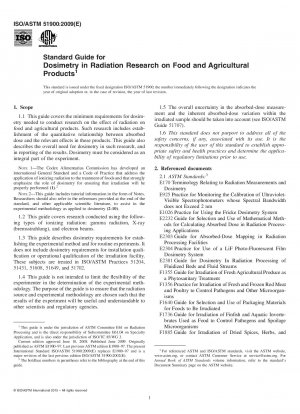ASTM ISO/ASTM 51900-09
Standard Guide for Dosimetry in Radiation Research on Food and Agricultural Products
- Standard No.
- ASTM ISO/ASTM 51900-09
- Release Date
- 2009
- Published By
- American Society for Testing and Materials (ASTM)
- Status
- Replace By
- ASTM ISO/ASTM 51900-09(2017)
- Latest
- ASTM ISO/ASTM 51900-23
- Scope
4.1 This guide is intended to provide direction on dosimetry for experiments in food and agricultural research, and on the reporting of dosimetry results. Research concerning the effectiveness of irradiation of food and agricultural products to achieve a defined benefit involves very different absorbed-dose specifications from one study and one product to another. For example, the absorbed dose required to sterilize fruit flies is much lower than the doses required to inactivate some bacterial pathogens in meat, or to decontaminate spices.
NOTE 4 - Examples of the relevant effects of irradiation include reduction of viable food-borne bacteria, viruses and parasites and phytosanitary treatment (such as disinfestation of fruits and vegetables), prevention of sprouting, delay of ripening, and changes in product chemistry and quality. Further discussion of these effects is outside the scope of this guide. Refer to ASTM Guides F 1355, F 1356, F 1736 and F 1885.
4.2 Proper reporting of the irradiation aspect is important since the degree of biological effect may be a function of various factors such as the radiation source, the absorbed-dose rate, energy of the incident radiation, environmental effects during irradiation, and the type of incident radiation. This guide attempts to highlight the information, including the methodology and results of the absorbed-dose measurements, necessary for an experiment to be repeatable by other researchers.
NOTE 5 - Factors that may influence the response of agricultural products to ionizing radiation include genus, species, variety, vigor, life stage, initial quality, state of ripeness, temperature, moisture content, pH, packaging, shipping, and storage conditions. Although these factors are not discussed in this guide, they should be considered when planning experiments (see ASTM Guides F 1355, F 1356, F 1640, F 1736 and F 1885.
4.3 Ideally, an experiment should be designed to irradiate the sample as uniformly as possible. In practice, a certain variation in absorbed dose will exist throughout the sample. Absorbed-dose mapping is used to determine the magnitude, location, and reproducibility of the maximum (Dmax) and minimum absorbed dose (Dmin) for a given set of experimental parameters. Dosimeters used for dose mapping must be capable of responding to doses and dose gradients likely to occur within irradiated samples.
4.4 Theoretical calculations may provide useful information about absorbed-dose distribution in the irradiated sample, especially near material interfaces (see ASTM Guide E 2232).
1.1 This guide covers the minimum requirements for dosimetry and absorbed-dose validation needed to conduct research on the irradiation of food and agricultural products. Such research includes establishment of the quantitative relationship between the absorbed dose and the relevant effects in these products. This guide also describes the overall need for dosimetry in such research, and in reporting of the results.
1.2 This guide is intended for use by research scientists in the food and agricultural communities, and not just scientists conducting irradiation research. It, therefore, includes more tutorial information than most other ASTM and ISO/ASTM dosimetry standards for radiation processing.
1.3 This guide is in no way intended to limit the flexibility of the experimenter in the experimental design. However, the radiation source and experimental set up should be chosen such that the results of the experiment will be beneficial and understandable to other scientists, regulatory agencies, and the food and agricultural communities.
1.4 The effects produced by ionizing radiation in biological systems depend on a large number of factors which may be physical, physiological, or chemical. Although not treated in detail in this guide, quantitative data of environmental factors that may affect the absorbed-dose response of dosimeters, ......
ASTM ISO/ASTM 51900-09 history
- 2019 ASTM ISO/ASTM 51900-23 Standard Guidance for Dosimetry for Radiation Research
- 2016 ASTM ISO/ASTM 51900-09(2017) Standard Guide for Dosimetry in Radiation Research on Food and Agricultural Products
- 2009 ASTM ISO/ASTM 51900-09 Standard Guide for Dosimetry in Radiation Research on Food and Agricultural Products
